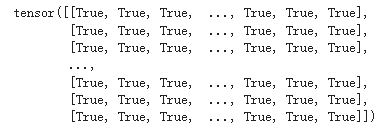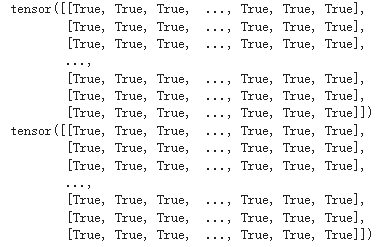关于torch.nn.LSTM()的输入和输出
主角torch.nn.LSTM()
初始化时要传入的参数
| Args:
| input_size: The number of expected features in the input `x`
| hidden_size: The number of features in the hidden state `h`
| num_layers: Number of recurrent layers. E.g., setting ``num_layers=2``
| would mean stacking two LSTMs together to form a `stacked LSTM`,
| with the second LSTM taking in outputs of the first LSTM and
| computing the final results. Default: 1
| bias: If ``False``, then the layer does not use bias weights `b_ih` and `b_hh`.
| Default: ``True``
| batch_first: If ``True``, then the input and output tensors are provided
| as `(batch, seq, feature)` instead of `(seq, batch, feature)`.
| Note that this does not apply to hidden or cell states. See the
| Inputs/Outputs sections below for details. Default: ``False``
| dropout: If non-zero, introduces a `Dropout` layer on the outputs of each
| LSTM layer except the last layer, with dropout probability equal to
| :attr:`dropout`. Default: 0
| bidirectional: If ``True``, becomes a bidirectional LSTM. Default: ``False``
| proj_size: If ``> 0``, will use LSTM with projections of corresponding size. Default: 0
input_size:一般是词嵌入的大小
hidden_size:隐含层的维度
num_layers:默认是1,单层LSTM
bias:是否使用bias
batch_first:默认为False,如果设置为True,则表示第一个维度表示的是batch_size
dropout:直接看英文吧
bidirectional:默认为False,表示单向LSTM,当设置为True,表示为双向LSTM,一般和num_layers配合使用(需要注意的是当该项设置为True时,将num_layers设置为1,表示由1个双向LSTM构成)
模型输入输出-单向LSTM
import torch
import torch.nn as nn
import numpy as np
inputs_numpy = np.random.random((64,32,300))
inputs = torch.from_numpy(inputs_numpy).to(torch.float32)
inputs.shape
torch.Size([64, 32, 300]):表示[batchsize, max_length, embedding_size]
hidden_size = 128
lstm = nn.LSTM(300, 128, batch_first=True, num_layers=1)
output, (hn, cn) = lstm(inputs)
print(output.shape)
print(hn.shape)
print(cn.shape)
torch.Size([64, 32, 128])
torch.Size([1, 64, 128])
torch.Size([1, 64, 128])
说明:
output:保存了每个时间步的输出,如果想要获取最后一个时间步的输出,则可以这么获取:output_last = output[:,-1,:]
h_n:包含的是句子的最后一个单词的隐藏状态,与句子的长度seq_length无关
c_n:包含的是句子的最后一个单词的细胞状态,与句子的长度seq_length无关
另外:最后一个时间步的输出等于最后一个隐含层的输出
output_last = output[:,-1,:]
hn_last = hn[-1]
print(output_last.eq(hn_last))

模型输入输出-双向LSTM
首先我们要明确:
output :(batch, seq_len, num_directions * hidden_size)
h_n:(num_layers * num_directions, batch, hidden_size)
c_n :(num_layers * num_directions, batch, hidden_size)
其中num_layers表示层数,这里是1,num_directions表示方向数,由于是双向的,这里是2,也是,我们就有下面的结果:
import torch
import torch.nn as nn
import numpy as np
inputs_numpy = np.random.random((64,32,300))
inputs = torch.from_numpy(inputs_numpy).to(torch.float32)
inputs.shape
hidden_size = 128
lstm = nn.LSTM(300, 128, batch_first=True, num_layers=1, bidirectional=True)
output, (hn, cn) = lstm(inputs)
print(output.shape)
print(hn.shape)
print(cn.shape)
torch.Size([64, 32, 256])
torch.Size([2, 64, 128])
torch.Size([2, 64, 128])
这里面的hn包含两个元素,一个是正向的隐含层输出,一个是方向的隐含层输出。
#获取反向的最后一个output
output_last_backward = output[:,0,-hidden_size:]
#获反向最后一层的hn
hn_last_backward = hn[-1]
#反向最后的output等于最后一层的hn
print(output_last_backward.eq(hn_last_backward))
#获取正向的最后一个output
output_last_forward = output[:,-1,:hidden_size]
#获取正向最后一层的hn
hn_last_forward = hn[-2]
# 反向最后的output等于最后一层的hn
print(output_last_forward.eq(hn_last_forward))

https://www.cnblogs.com/LiuXinyu12378/p/12322993.html
https://blog.csdn.net/m0_45478865/article/details/104455978
https://blog.csdn.net/foneone/article/details/104002372




